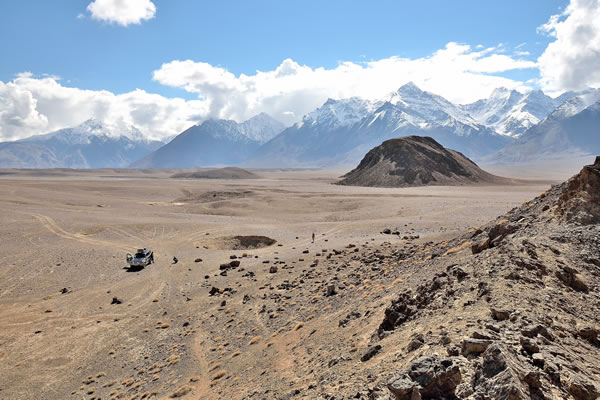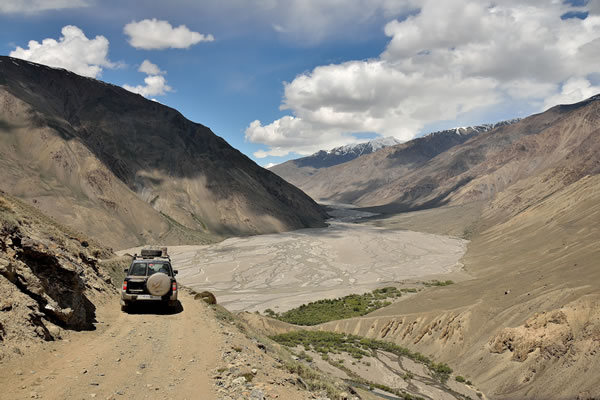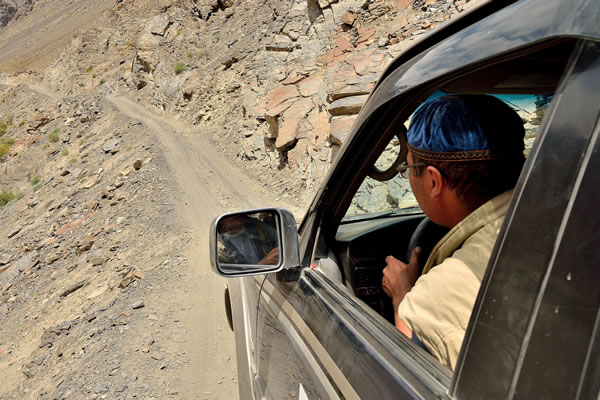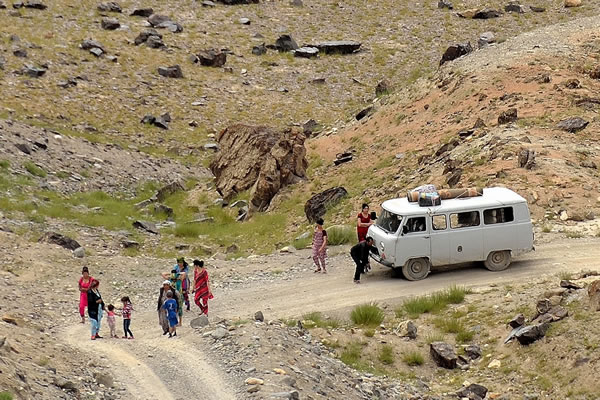

| The Bartang valley: one of the wildest parts of the Pamirs | |
Khujand (Tajikistan), July 16th 2015
|
|
|
|
|
Like most travellers we love maps. What is more fun than gazing at a map and wondering how all these villages and roads look in real life. While preparing our jeep trip through the Pamir Mountains was one "road" on the map that always caught our eye. A broken line that followed the Bartang River and that should be a bad jeep track according to the legend of the map. That’s where we wanted to go! After much searching we found a travel agent (www.pamirguides.com) who wanted to rent us a jeep and driver to drive through this area. A long-cherished wish is coming true; the Bartang valley is one of the most remote and rugged areas in the already desolate Pamir Mountains and this trip gives us the opportunity to get an impression of this valley. The logical starting point of our journey through the Valley Bartang trip is Jalang (altitude of 4100 metres). While officially not part of the Bartang Valley, this beautiful nomad settlement is only 60 kilometres away from the Kok Jar pass, which is the access point to the Bartang Valley. Jalang, however, is a wonderful place where you want to stay at least an afternoon. Kyrgyz nomads come to this summer pasture near a mountain stream with their yurts, so their cattle can feed on the grass that grows here. The Pamir Mountains are generally barren, rocky, rough and dry, but because there is a lot of snow in winter, there is also a lot of meltwater in the summer. Along the streams and rivers are green ribbons of vegetation where the yaks and goats can eat. Once the area around the nomad tents has no longer enough food for the animals, the nomads pack up again to move to the next place. Life in Jalang is simple. Running water is available in the form of the river, the toilet is no more than a piled up, half-high wall of rocks around a hole. However, nature is stunningly beautiful and the hospitality is second to none. Since there is no mobile phone coverage is in these places, people do not know when visitors are coming. Nevertheless, as soon as we arrive there is a lunch prepared with the ingredients that are abound here. Bread (baked on the stove fired yak dung) with yak yoghurt, yak butter, yak cream and delicious plov (Rice with onions, goat fat and goats meat). We wonder how the nomads get the flour for the bread and the onions and the rice. This is simple. Every few weeks a kind of truck shop drives to several nomad camps with all kinds of things that nomads might need. These items are exchanged for the products that the nomads make from the yak milk. |
|
 |
|
Spectacular landscape at the meteor crater at approx 30 km before the Kök Jar Pass |
|
After a night in beautiful Jalang, the tour through the Bartang Valley really begins. The 60 kilometres that separate us from the metre high Kok Jar pass is going through an indescribable area. The vastness of the plains and the high, snow-capped peaks that surround them are magnificent. In this area, the impact of a meteorite left a huge crater. On another place, ancient nomadic people created a kind solar calendar with stones. While the solar calendar doesn’t seem very special, the stop gives our driver the opportunity to change his tire. The stones that we drive on are razor sharp and therefore a real challenge for the tires. From the Kok Jar pass, the adventure really begins. On the pass on an altitude of 4000 meters, there is a small camp with some Tajik shepherds and this is the last sign of human habitation that we will see in the next 50 kilometres. In these 50 kilometres we descend on a very bad, rocky path to the small village of Ghudara. The road is hair-raisingly narrow in some places, while the deep escarpment looms next to it. We are the first travellers this year who descend with a jeep through the Bartang Valley, so our driver Shamil doesn’t know what to expect from the road ahead. In winter, there falls a lot of snow in these areas, which can cause landslides and avalanches. The greatest fear of Shamil is that large boulders block the road or that parts of the road are washed away, so we cannot go through. To assist Shamil with this challenge, Pamir Guides added a guide (Kurbanali) to our team, at the last moment (at their expense). Kurbanali, however, is more working as road worker than as a guide. Every few minutes he is busy with the removal of rocks and stones, so our Nissan Patrol can continue its path unscathed. Furthermore, Kurbanali acts as an extra pair of eyes for Shamil, to make sure that we do not collapse into a deep ravine; also very useful! The Bartang valley is the gap where the Bartang River flows through. It is a narrow valley that looks different at every turn. The colours of the rocks vary from grey-green to pink-red and the road that leads us through this area is miraculously carved out of rocks. While we enjoy the beautiful scenery surrounding us, pearls of sweat appear on Shamil’s forehead. Regularly he sighs, "Oh Bartang" as his Nissan makes a big smack on the big boulders. On this stretch of road, we don’t see any other vehicles or people. If we ask Shamil what he would do if his car would break down, he looks with glistening eyes toward the sky: "I hope Allah will let my car survive the Bartang Valley!" Once in Gudara (altitude 3050 metres), we leave the most difficult part of the route behind us. Simultaneously, Shamil and Kurbanali rub with their hands through their faces, indicating that they thank Allah for His assistance during these tough route. Gudara is the first real village that we encounter on this side of the Kok Jar pass. The people that live on this side of the pass, have the Pamir ethnicity, while in Jalang we were surrounded by Kyrgyz people. The appearance of the people is different as well as their clothing and religion. Here one believes in the Ismail version of Islam. The Pamirs live in typical Pamir houses: simple from outside but beautifully decorated inside. In the living room, people are sitting on thick mats on raised platforms. Five wooden pillars symbolize five members of the family of Muhammad. A Pamir lady assures us that if an earthquake strikes, you must hold the pillar that represents Mohammed. He will give protection. |
|
 |
|
Views from the Kök Jar Pass |
|
We stay with a local family in Savnob, a small village about fifty kilometers from Gudara. We have descended to 2680 meters, making the temperature much higher than in Jalang. Through irrigation, the small piece of flat land along the river has been transformed into fresh green farm fields. Vegetables are therefore also part of the daily fare. The river also provides power for the village through a small hydroelectric power system. The power supply is still erratic and weak, but it is still much more than one can count on in many parts of the Pamirs. The next morning we head for the village Sponge (Altitude: 2172 meters). The road is better than yesterday, but a four-wheel drive car is not a luxury. According to Shamil there are travellers who traverse this route on off-road motorcycles and mountain bikes. They have the advantage that they do not suffer from the narrow road and they can drive around the large stones. Also today, the landscape of the route is phenomenal. The road continues to follow the Bartang River. Time after time it climbs a few hundred meters to descend back to the level of the river afterwards. The views over the river and the small settlements are beautiful. Slowly but surely the density of settlements grows. Occasionally we see Russian four-wheel drive minivans that the only form of public transport in the lower part of the Bartang Valley. Nearly every day, it is possible to travel with such a minibus to Khorog, the main town of the Pamirs. (There is no public transport on the road from the Kok Jar Pass to Gudara). From Sponge, Shamil brings us to a pedestrian bridge near Khijez so that we can make a day hike to Jizeu. Jizue is a small village on an altitude of 2500 metres that is only accessible by foot and consists of only 14 households. The location of the village, at a crystal clear lake, is beautiful. Jizue is an easy option for people who want to get a feeling of the Bartang valley without hitting the road with a Jeep, off-road motorcycles or bicycles. With a regular car, the pedestrian bridge to Jizue can be reached in just a few hours from Khorog. In Jizue there are sufficient homestay addresses to stay for a few days. In Rushan, our adventure in the Bartang Valley comes to an end. The vast, rugged nature of this region have left an indelible impression on us. The road dotted on the map on which we had fantasized so often, we can now fill in with beautiful memories. The Bartang valley is recommended for anyone who loves wild nature, remote areas and hospitable people. However, if you need any kind of luxury during your trip, you should reconsider this trip. This is a place for those who travel to see and experience things and who don’t mind sacrificing some comfort. |
|
 |
|
The road through the Bartang Valley is at some stretches horrible |
|
 |
|
The narrow track demands the full attention of the driver |
|
 |
|
A Russian made UAZ minivan breaks down. Walking is the only option. |
|
 |
|
The Geisev or Jizeu Valley, is a side valley of the Bartang Valley |
|
 |
|
Old machines keep the Bartang Valley accessible © copyright - Babakoto.eu / 2015 |
|